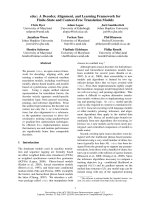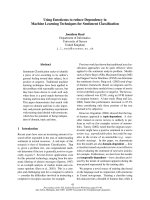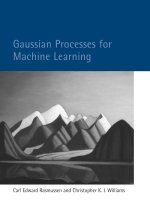Machine learning representation for atomic forces and energies
Bạn đang xem bản rút gọn của tài liệu. Xem và tải ngay bản đầy đủ của tài liệu tại đây (833.73 KB, 7 trang )
VNU Journal of Science: Mathematics – Physics, Vol. 36, No. 2 (2020) 74-80
Original Article
Machine Learning Representation
for Atomic Forces and Energies
Pham Tien Lam1, 2,*, Nguyen Van Duy1, 2, Nguyen Tien Cuong3
1
Phenikaa Institute for Advanced Study, Phenikaa University, Ha Dong, Hanoi, Vietnam
2
Faculty of Computer Science, Phenikaa University, Ha Dong, Hanoi, Vietnam
3
VNU University of Science, 334 Nguyen Trai, Thanh Xuan, Hanoi, Vietnam
Received 13 February 2020
Revised 13 March 2020; Accepted 25 March 2020
Abstract: We present machine learning models for fast estimating atomic forces and energies. In
our method, the total energy of a system is approximated as the summation of atomic energy which
is the interaction energy with its surrounding chemical environment within a certain cutoff radius.
Atomic energy is decomposed into two-body terms which are expressed as a linear combination of
basis functions. For the force exerted on an atom, we employ a linear combination of a set of basis
functions for representing pairwise force. We use least-square linear regression regularized by the
l2-norm, known as Ridge regression, to estimate model parameters. We demonstrate that we can
train linear model to accurately predict atomic forces and energies in comparison to densityfunctional-theory (DFT) calculations for crystalline and amorphous silicon. The machine learning
force model is then applied to calculate the phonon dispersion of crystalline silicon. The result shows
reasonable agreement with DFT calculations.
Keywords: Machine Learning, molecular dynamics, force field, materials informatics.
1. Introduction
The computation of the energies, especially the forces of a chemical system, play a central role in
the computational design of matter and materials. The energies and forces can be obtained by performing
electronic structure calculations such as those based on density functional theory (DFT) [1–3]. Although
________
Corresponding author.
Email address:
https//doi.org/ 10.25073/2588-1124/vnumap.4464
74
P.T. Lam et al. / VNU Journal of Science: Mathematics – Physics, Vol. 36, No. 2 (2020) 74-80
75
DFT has become a standard method in the computer simulations of matter, it continues to remain
computationally expensive. The energies and forces of a large system can also be approximated by using
an empirical model with much lower computational cost. Typically, a potential energy surface (PES) is
constructed as the sum of simple low-dimensional terms (structural elements) representing covalent
bonds, angles, and dihedral angles [4]. These methods are efficient and are applied widely for simulating
large biosystems, but they can hardly describe chemical reactions that involve the formation or
dissociation of covalent bonds.
In recent years, alternative methods, which learn the PES from a set of materials structures and the
corresponding DFT energies, have been developed [5–11]. These methods employ machine learning
algorithms to determine the functional relationship between the structure and energy of a material.
Normally, to build the machine learning models the total energy of a material is decomposed into the
sum of all energies of the constituent atoms determined by interactions among these atoms and with
atoms in the surrounding chemical environment within a cutoff radius.
Although atomic forces, which is a vector quantity, can be calculated by obtaining the gradient of
the total energy, this approach would hardly be successful when the learned functional relationship
between the material structure and energy is complicated, such as deep-learning models. Therefore, the
machine learning models for representing the atomic forces are highly desired. In this work, we examine
a linear representation for atomic energies on atomic forces. For the atomic forces, we develop linear
models for the direct representation of atomic forces in terms of pairwise-force functions.
2. Computational Methods
2.1. Modeling Potential Energy Surface
To model the potential energy surface, we assume that the total energy of a chemical system is the
summation of effective atomic energy of the constituent atoms [9,10,12–15]: 𝐸 = ∑𝑖 𝐸𝑖 , where 𝐸 is the
total energy and 𝐸𝑖 is the effective energy measuring the contribution of atom 𝑖 to the total energy. The
effective energy of atom 𝑖 can be represented based on its interactions with neighboring atoms within a
cutoff radius, 𝑟𝑐 . In this work, we only focus on the two-body interactions. In principle, we can extend
the effective atomic energy to higher order.
𝐸𝑖 = ∑ 𝐸𝑖𝑗 = ∑ ∑ 𝑐𝑘 𝑏𝑘 (𝑟𝑖𝑗 , 𝑣𝑖 , 𝑣𝑗 ) = ∑ 𝑐𝑘 ∑ 𝑏𝑘 (𝑟𝑖𝑗 , 𝑣𝑖 , 𝑣𝑗 ) = ∑ 𝑐𝑘 𝑥𝑘
𝑗
𝑗
𝑘
𝑘
𝑗
(1)
𝑘
where 𝑥𝑘 = ∑𝑗 𝑏𝑘 (𝑟𝑖𝑗 , 𝑣𝑖 , 𝑣𝑗 ), 𝑏𝑘 (𝑟𝑖𝑗 , 𝑣𝑖 , 𝑣𝑗 ) are basis functions, 𝑐𝑘 are expansion coefficients, and
𝑣𝑖 and 𝑣𝑖 are feature vectors encoding the information of atom 𝑖 and 𝑗, respectively. To enhance the
nonlinearity representation, we also include the polynomial terms of two-body term up to order 𝑝:
(1)
(2)
(𝑝) 𝑝
𝐸𝑖 = ∑ 𝑐𝑘 𝑥𝑘 + ∑ 𝑐𝑘 𝑥𝑘2 … ∑ 𝑐𝑘 𝑥𝑘
𝑘
𝑘
(2)
𝑘
In this work, we focus on silicon systems and examine the Gaussian and cosine basis function for
representing their potential energy surfaces. Since the atomic information is identical for all silicon atom,
we can remove 𝑣𝑖 and 𝑣𝑗 in Eq. 2. Eq. 2 can be reduced to more simple form:
2
𝐸𝑖 = ∑𝑘 𝑐𝑘 𝑏(𝑟𝑖𝑗 )𝑘 . We use following forms: 𝑏𝑘 (𝑟𝑖𝑗 ) = 𝑒 𝜂𝑘 (𝑟−𝑟𝑘 ) 𝑓𝑐 (𝑟𝑖𝑗 ) and 𝑏𝑘 (𝑟𝑖𝑗 ) =
cos(𝜅𝑘 𝑟𝑖𝑗 ) 𝑓𝑐 (𝑟𝑖𝑗 ) for Gaussian and cosine basis functions, respectively, where 𝜂𝑘 , 𝑟𝑘 , and 𝜅𝑘 are
76
P.T. Lam et al. / VNU Journal of Science: Mathematics – Physics, Vol. 36, No. 2 (2020) 74-80
parameters defined the basis functions, 𝑓𝑐 (𝑟𝑖𝑗 ) is a smooth-cutoff function which ensures that the atomic
energy varies smoothly at the cutoff radius:
𝜋𝑟𝑖𝑗
0.5 [𝑐𝑜𝑠 (
) + 1] 𝑖𝑓 𝑟𝑖𝑗 < 𝑟𝑐
𝑟𝑐
𝑓𝑐 (𝑟𝑖𝑗 ) = {
(3)
0 𝑖𝑓 𝑟𝑖𝑗 ≥ 𝑟𝑐
(𝑝)
We determine the linear coefficient, 𝑐𝑘 by a linear regression for DFT Energies. We use leastsquare linear regression regularized by the l2-norm, known as Ridge regression [9], to estimate model
parameters.
2.2. Modeling Atomic Force
To model the force on an atom we only consider the interactions of its neighboring atoms within a
cutoff radius. The force that acts on an atom is a superposition of all pairwise forces between the central
atom and its neighboring atoms:
𝑟⃗𝑖𝑗
𝑓⃗𝑖 = ∑ 𝑓⃗𝑖𝑗 = ∑ 𝐹𝑖𝑗 (𝑟𝑖𝑗 , 𝑣𝑖 , 𝑣𝑗 ) 𝑓𝑐 (𝑟𝑖𝑗 )
(4)
𝑟𝑖𝑗
𝑗
𝑗
where 𝑓⃗𝑖 is the force acting on atom i, 𝑓⃗𝑖𝑗 is the force exerted on atom 𝑖 by atom 𝑗, 𝐹𝑖𝑗 (𝑟𝑖𝑗 , 𝑣𝑖 , 𝑣𝑗 ) is
a pairwise-force function, and 𝑓𝑐 (𝑟) is the smooth cutoff function. The pairwise-force function which
depends the distance between atoms, 𝑟𝑖𝑗 , and the intrinsic properties of atoms represented by feature
vectors, 𝑣𝑖 and 𝑣𝑗 . The pairwise-force function measures the strength of the force atom j exerts on atom
i. Each component of the atomic force can be expressed by following equation:
𝑟𝑖𝛼 − 𝑟𝑗𝛼
𝑓𝑖𝛼 = ∑ 𝐹𝑖𝑗 (𝑟𝑖𝑗 , 𝑣𝑖 , 𝑣𝑗 )
𝑓𝑐 (𝑟𝑖𝑗 )
(5)
𝑟𝑖𝑗
𝑗
where 𝑓𝑖𝛼 is the α component of 𝑓⃗𝑖 where 𝛼 ∈ {𝑥, 𝑦, 𝑧}. We represent the pairwise-function by a
linear combination of basis functions.
𝐹(𝑟𝑖𝑗 , 𝑣𝑖 , 𝑣𝑗 ) = ∑ 𝑐𝑘 𝑏𝑘 (𝑟𝑖𝑗 , 𝑣𝑖 , 𝑣𝑗 )
(6)
𝑘
Combining Eq. 2 and Eq. 3, we can express the Cartesian force components as follows:
𝑟𝑖𝛼 − 𝑟𝑗𝛼
𝑓𝑖𝛼 = ∑ 𝑐𝑘 ∑ 𝑏𝑘 (𝑟𝑖𝑗 , 𝑣𝑖 , 𝑣𝑗 )
𝑓𝑐 (𝑟𝑖𝑗 )
𝑟𝑖𝑗
𝑘
(7)
𝑗
Therefore, one can determine the linear coefficient, 𝑐𝑘 by a linear regression for DFT forces, 𝑓𝑖𝛼 .
We also employ Ridge regression in order to estimate model parameters [9] and investigate the Gaussian
and cosine basis functions, as described in section 1, for representation of the pairwise-force.
2.3. Data Preparation
We examine our method to silicon system. We used a 2×2×2 Si supercell that includes 64 Si atoms
as training data and a 3×3×3 Si supercell with 216 atoms as the test data for the larger system. The
systems were relaxed by performing a molecular dynamics (MD) calculations at 2,000 K in the NPT
ensemble by the Car–Parrinello method [3]. Then, they were equilibrated at 1,000 K in the NPT
ensemble. The pressure was standard ambient atmospheric pressure (1.01325 bar). We collected 3,000
structures in the equilibrated trajectories of the 2×2×2 cell training the data of the 3×3×3 cell as test
P.T. Lam et al. / VNU Journal of Science: Mathematics – Physics, Vol. 36, No. 2 (2020) 74-80
77
data. Additionally, we examined the applicability of our method to a large range of forces by adding
uniform random displacement with a magnitude of 0.3Å to the coordinates of each atom in those
structures equilibrated at 1,000 K. The energies and forces of the structures were calculated by using the
PWSCF code [20, 21]. We employed the PBE exchange-correlation functional [22, 23] to process the
exchange-correlation energy, plane wave basis set with the cutoff energy of 40 Ry, and ultrasoftpseudopotential [24] for approximating the interaction between the valence electrons and core electrons.
A 3×3×3 Monkhorst–Pack grid of k-points was employed for the Brillouin-zone integrations of 2×2×2
Si supercell, while a 2×2×2 grid was applied for 3×3×3 supercell.
3. Results and Discussion
3.1. Prediction of Total Energy
We use the cutoff radius of 8 Å and investigate the dependence of the prediction of the potential
energy surface on the number of basis functions. For the Gaussian functions, we use first use the
functions with the center is the center atom, 𝑟𝑘 = 0.0. The number of Gaussian basis functions is defined
by the parameter, 𝜂𝑚𝑎𝑥 . The parameters 𝜅𝑘 ∈ {0.05, 0.10, … , 𝜅𝑚𝑎𝑥 } are used for the cosine functions,
and the number basis function is also determined by the parameter 𝜅𝑚𝑎𝑥 .
Table 1. The mean absolute error (MAE) in meV/atom for the test set derived from 2×2×2 supercell
Basis
Function
Gaussian
Cosine
#functions
p=1
p=2
p=3
20
40
60
20
40
60
8.9
8.4
8.1
31.6
10.4
9.8
8.5
8.3
7.9
28.7
10.8
9.3
8.0
7.9
8.2
31.1
10.6
10.2
We first examine our model for the potentials energy surface of 2×2×2 system. We divide the data
set of 3000 structures into the training set of 2400 structures and the test set of 600 structures. The
performance of models derived from Gaussian and cosine basis functions is shown in Table 1. It can be
seen that for this system, the polynomial terms, as described in Eq. 3, do not significantly improve the
accuracy of the prediction. And the Gaussian basis functions seem to yield better performance in
presenting the two-body terms for the potential energy surface of silicon systems.
We also extend the Gaussian basis functions with different centers: 𝑟𝑘 ∈ {0, 1, 2, . . ,7, 8} and 𝜂𝑘 ∈
{0.05, 0.10, … , 𝜂𝑚𝑎𝑥 }. By using 𝜂𝑚𝑎𝑥 of 2.0, we can slightly improve the accuracy with MAE of 7.7
meV/atom. Using these basis functions and 3000 2×2×2-structures as training set, we can well reproduce
the DFT energy for 3×3×3 system with similar accuracy.
3.2. Prediction of Atomic Forces
We use the same procedure to specify the basis functions for the pairwise forces between silicon
atoms. We also first study the 2×2×2 systems with 2400 structures for the training set and 600 structures
for the test set. Fig. 1 illustrates the dependence of the root mean square error (RMSE) on the number
of basis functions. One can see that it requires smaller number of Gaussian function than that of cosine
functions for the prediction of atomic forces.
78
P.T. Lam et al. / VNU Journal of Science: Mathematics – Physics, Vol. 36, No. 2 (2020) 74-80
Fig. 1. The root mean square error (RMSE) estimated on the test set of the 2×2×2 supercell
as the function of the basis functions.
Fig. 2 shows the comparison between machine-learning forces and DFT forces for the training set
(red) and the test set (blue). We can clearly see the good agreement between our model and the DFT
calculations. For the model using 60 Gaussian basis function, we can obtain the accuracy with RMSE
of 0.11 eV/ Å, MAE of 0.08 eV/ Å, and R2 score of 0.99.
Fig. 2. The comparison of machine-learning forces and DFT forces for the training set (red)
and the test set (blue).
Fig. 3. The pairwise force function: by Gaussian (green) and cosine (red) basis functions.
P.T. Lam et al. / VNU Journal of Science: Mathematics – Physics, Vol. 36, No. 2 (2020) 74-80
79
We examine the pairwise functions represented by cosine and Gaussian functions, and the results
are shown in Fig. 3. The cosine and Gaussian representations show a good agreement for approximating
the pairwise function. It is observed that there might exist the attraction between Si atoms in the range
of 2.3-7.0 Å. The interaction between Si atoms converges to zero at long distances. Interestingly, the
interaction vanishes at 2.3 Å and 3.3 Å, which are corresponding to the first and second nearest
neighbors in the crystalline silicon. The results imply that we can learn for the hidden knowledge of the
pairwise interaction of Si atoms, which is not available in first-principles calculations.
We apply the our model to the calculation of phonon dispersion for Si with a 2×2×2 supercell. The
phonon dispersions were calculated by using the supercell approach [16] implemented in Phonopy code
[17]. Fig. 4, which shows the phonon dispersion for diamond Si using our machine learning model using
60 Gaussian and cosine basis functions, and DFT calculations, shows that the phonon dispersions
obtained with these two methods are in good agreement. The slight difference indicates the limit of our
method with respect to the prediction of small forces.
Fig. 4. The phonon band structure and density of state (DOS): by Gaussian (green)
and cosine (red) basis function.
We examined the transferability of our models trained by the 2×2×2 silicon system, by comparing
the predicted forces and DFT forces of the 3×3×3 silicon system. A test set with 300 structures of the
3×3×3 supercell was used for the test. We obtained an the similar accuracy with RMSE of 0.11 eV/Å
and MAE of 0.08 eV/Å for the 3×3×3 system. This result confirms that our model, which is trained with
a small system, is transferable to large systems.
4. Conclusion
We report on a machine learning procedure for representing the potential energy surface and atomic
forces from two-body terms. We can train linear models to accurately predict atomic forces and energies
comparable to those obtained by density functional theory (DFT) calculations for crystalline and
amorphous silicon. The machine learning force model is then applied to calculate the phonon dispersion
of crystalline silicon. The result shows reasonable agreement with DFT calculations. We also show that
the models learned from 2×2×2 data can extend to predict the potential energy surface and atomic force
for 3×3×3 systems.
80
P.T. Lam et al. / VNU Journal of Science: Mathematics – Physics, Vol. 36, No. 2 (2020) 74-80
Acknowledgment
This research is funded by Vietnam National Foundation for Science and Technology Development
(NAFOSTED) under grant number 103.01-2019.30
References
[1] R. Car, M. Parrinello, Unified approach for molecular dynamics and density-functional theory, Phys. Rev. Lett. 55
(1985) 2471–2474. />[2] W. Kohn, L.J. Sham, Self-Consistent Equations Including Exchange and Correlation Effects, Phys. Rev. 140 (1965)
1133. />[3] P. Hohenberg, W. Kohn, Inhomogeneous Electron Gas, Phys. Rev. 136 (1964) 5188.
/>[4] C.M. Handley, J. Behler, Next generation interatomic potentials for condensed systems, Eur. Phys. J. B. 87 (2014)
152. />[5] A.P. Bartók, G. Csányi, Gaussian approximation potentials: A brief tutorial introduction, Int. J. Quantum Chem.
115 (2015) 1051–1057. />[6] S. De, A.P. Bartók, G. Csanyi, M. Ceriotti, Comparing molecules and solids across structural and alchemical space,
Phys. Chem. Chem. Phys. 18 (2016) 13754–13769. />[7] A. Seko, et al., A sparse representation for potential energy surface, Phys. Rev. B. 90 (2014) 24101.
/>[8] M. Rupp, A. Tkatchenko, K.-R. Muller, O.A. von Lilienfeld, Fast and Accurate Modeling of Molecular
Atomization Energies with Machine Learning, Phys. Rev. Lett. 108 (2012) 58301.
/>[9] T.L. Pham, H. Kino, K. Terakura, T. Miyake, H.C. Dam, Novel mixture model for the representation of potential
energy surfaces, J. Chem. Phys. 145 (2016) 154103. />[10] J. Behler, M. Parrinello, Generalized Neural-Network Representation of High-Dimensional Potential-Energy
Surfaces, Phys. Rev. Lett. 98 (2007) 146401. />[11] N. Artrith, J. Behler, High-dimensional neural network potentials for metal surfaces: A prototype study for copper,
Phys. Rev. B. 85 (2012) 45439. />[12] J. Behler, Atom-centered symmetry functions for constructing high-dimensional neural network potentials, J. Phys.
Chem. 134 (2011) 74106. />[13] T. Lam Pham, H. Kino, K. Terakura, T. Miyake, K. Tsuda, I. Takigawa, H. Chi Dam, Machine learning reveals
orbital interaction in materials, Sci Technol Adv Mater. 18 (2017) 756–765.
/>[14] T.L. Pham, N.D. Nguyen, V.D. Nguyen, H. Kino, T. Miyake, H.C. Dam, Learning structure-property relationship
in crystalline materials: A study of lanthanide-transition metal alloys, J. Chem. Phys. 148 (2018).
/>[15] V.-D. Nguyen, T.-L. Pham, H.-C. Dam, Application of materials informatics on crystalline materials for two-body
terms approximation, Comput. Mater. Sci. 166 (2019) 155–161.
/>[16] K. Parlinski, Z.Q. Li, Y. Kawazoe, First-Principles Determination of the Soft Mode in Cubic ZrO 2, Phys. Rev.
Lett. 78 (1997) 4063–4066. />[17] A. Togo, I. Tanaka, First principles phonon calculations in materials science, Scr. Mater. 108 (2015) 1–5.
/>





![data mining and machine learning in cybersecurity [electronic resource]](https://media.store123doc.com/images/document/14/y/op/medium_hJlflZCPev.jpg)



